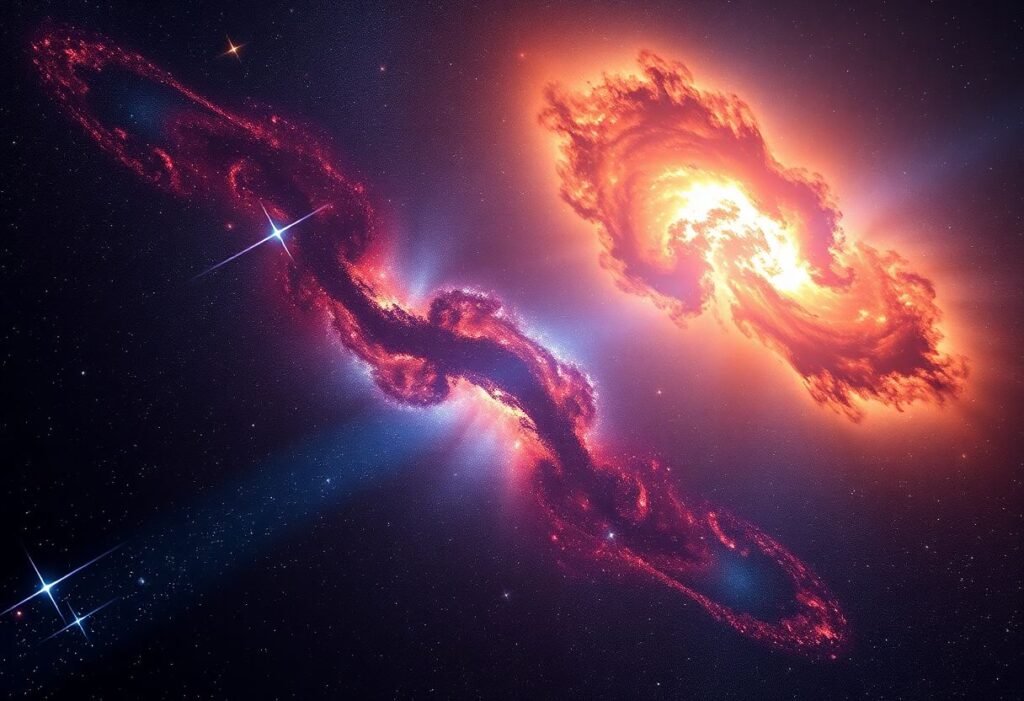Astronomy is filled with mysteries, and recent findings reveal a colossal structure that reshapes our understanding of cosmic phenomena. Researchers have discovered giant cosmic jets emanating from a supermassive black hole, which surpasses any previously known energy output. This surge released from the black hole showcases the immense power of these astronomical giants, illuminating the galaxy and revealing the universe’s hidden wonders.
The Discovery of Giant Cosmic Jets
Researchers have identified an extraordinary cosmic structure resembling a gigantic chimney, extending across a staggering distance comparable to 140 Milky Ways lined up side by side. These monumental jets are propelled from a supermassive black hole, a force of nature previously unimagined. This discovery fundamentally alters our comprehension of black holes and their capabilities, sparking curiosity in the scientific community. The jets not only challenge existing theories but also pave the way for further investigation into the mechanics governing these astronomical phenomena. It is crucial for astrophysicists to broaden their research horizons in light of these findings.
The Energy Output of These Jets
The energy released by these cosmic jets is comparable to a trillion Suns, asserting their place among the most potent forces in the universe. This monumental release of energy raises questions about the black holes’ influence on their surrounding environment and the entire galaxy. Ongoing observations reveal that these jets can extend across vast distances, drastically impacting the intergalactic medium. As energy escapes these jets, it interacts with surrounding matter, fostering new insights into dark matter and the fundamental structure of our universe.
Implications for Astrophysics
Understanding these colossal jets is essential for comprehending the evolution of galaxies. The jets may play a significant role in regulating star formation and shaping the cosmic landscape. As they propagate through space, they create shock waves that can trigger or suppress the formation of new stars in adjacent regions. This dynamic interplay of forces contributes to maintaining the balance of energy and matter in galaxies. As researchers delve deeper, they may unravel the profound influences of these jets on galactic development.
Technological Advances Enabling Discovery
Recent technological advancements in observational capabilities have been crucial in uncovering these incredible cosmic phenomena. High-resolution telescopes and imaging techniques allow astronomers to study distant objects in greater detail than ever before. By utilizing radio, infrared, and X-ray telescopes, researchers can analyze various wavelengths of light emitted by the jets. This multifaceted approach provides a comprehensive understanding of their physical characteristics, leading to vital insights into their formation and behavior.
The Future of Cosmic Research
This groundbreaking discovery will likely influence the focus of future cosmic research. Scientists are now motivated to explore other supermassive black holes across the universe, searching for similar jets and their associated cosmic phenomena. Such investigations could reshape our understanding of the universe and contribute to more significant theoretical frameworks in astrophysics. The findings will continue to inspire new questions and foster innovative approaches in cosmic exploration.
Conclusions and Further Research
In conclusion, the identification of these colossal jets from supermassive black holes opens up new avenues in astrophysics, emphasizing the need for continued research. As these discoveries unfold, they challenge and enrich our understanding of cosmic structures and forces. It is essential to further investigate the mechanics and implications of these jets, as they hold the keys to unlocking many mysteries within our universe. By forging ahead with research, space enthusiasts and scientists alike can anticipate even more astonishing discoveries in the future.
Disclaimer: The information presented in this article is intended for informational purposes only and should not be construed as professional astronomical advice.





















